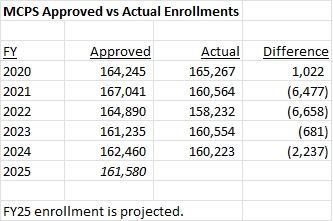By Adam Pagnucco.
The superintendent’s recommended budget is the first public step in MCPS’s operating budget process. The recommended budget for FY25 can be found here. Here are five interesting things I found in a quick and dirty read of this budget and a few more past budgets.
1. MCPS’s money ask primarily targets county government.
In FY24’s approved budget, 63% of MCPS’s money came from the county appropriation, 29% came from state aid, 4% came from the federal government and the rest came from fund balance, private grants and internally generated revenues (like fees). In FY25, the superintendent is requesting a $157 million increase, or 5.0% above FY24’s level. Here is how that increase is distributed across revenue sources.
County appropriation: +$166 million
State aid: +$10 million
Federal: +$1 million
Fund balance: -$25 million
Other: +$6 million
And so county taxpayers rather than other entities are on the hook for MCPS’s money request. Part of this is driven by the school system’s departure from its longstanding practice of using part of its fund balance to fund future budgets. That’s an interesting decision given that MCPS has seen substantial long-term growth in its fund balance in recent years. This is sure to draw questions at the council.
Also, MCPS is seeking an 8.3% increase in its county appropriation. That’s just short of last year’s 8.5% increase, which was the school system’s biggest local dollar increase in at least two decades.
2. Contractual services are growing four times faster than salaries and wages.
Contractual services are due to rise from $80 million to $93.5 million, an increase of 16.8%. Meanwhile, salaries and wages will rise just 4.2%. I wonder what MCPS’s labor unions will think about this.
3. Two years ago, MCPS spent $22 million less than its approved budget.
Let’s say this together: it’s never enough to look at approved budgets. You must always look at actual spending and compare it to approved budgets to figure out what’s really going on.
For most public budgets in Maryland, the current budget includes the approved (or recommended) budget for this year, the approved budget for last year and the actual budget from two years ago. That enables you to compare approved to actuals by stringing together a number of budgets in sequence.
The FY23 approved budget called for $2,920,027,627 in grand total operating spending. But according to the FY25 recommended budget, MCPS actually spent $2,897,568,070 in FY23 – or $22,459,557 less than approved. Why did it spend less? The primary reason is that it spent $15,335,501 less on instructional salaries than was allocated in its approved budget.
None of this is unusual. MCPS has been spending less than its approved budget for instructional salaries for many years and often transfers that money to other uses. The county council just approved another $11.4 million transfer out of instructional salaries in October.
MCPS regularly uses salaries to justify large budget increases like this new one proposed for FY25. This whole issue badly requires oversight from the county council.
4. MCPS has overestimated its enrollment for the last four years.
Just as you can compare approved to actual budgets, you can also compare approved to actual enrollments. The table below shows them in MCPS for the past five fiscal years.

Overestimation was understandable in FY21 and FY22 – those were the peak years of the pandemic. But it has continued in the two years since. These may be honest overestimates, but their effect has been to overstate MCPS’s budgetary needs.
In FY25, MCPS is projecting an enrollment of 161,580. That is 3,687 less than it was in FY20, or a 2.2% reduction. MCPS is now a smaller system than it was before the pandemic.
5. MCPS is budgeting for 43 fewer teacher positions in FY25.
MCPS is cutting its teacher positions from 12,454 in FY24 to 12,411 in FY25, a reduction of 43. It is still adding a net total of 209 positions, primarily by increasing positions in instructional support (+115), transportation (+51) and social work (+31).
The teachers union may be interested in the simultaneous reduction in teacher positions along with the above stated large increase in contractual services spending.
